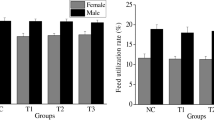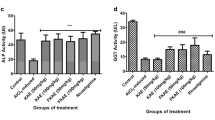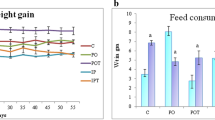Abstract
Kombucha tea is sugared black tea fermented with a consortium of bacteria and yeasts which forms tea fungus (Medusomyces gisevii) for 14 days. Kombucha tea is claimed to have various beneficial effects on human health but very less scientific evidences are available in the literature. In the present study, the prophylactic and curative effect of black tea (unfermented black tea) and kombucha black tea (KBT) on aflatoxin B1 induced liver damage was studied in male albino rats by analyzing hepatotoxicity markers (aspartate transaminase, alanine transaminase, alkaline phosphatase, gammaglutamyl transpeptidase), lipid peroxidation, reduced glutathione and antioxidant enzymes (glutathione-S-transferase, glutathione peroxidase, glutathione reductase, catalase and superoxide dismutase). Histopathological analysis of liver tissue was also carried out. Results revealed that kombucha tea is more potent in preventing hepatotoxicity than unfermented black tea. The mechanism of hepatoprotection offered by KBT treatment may involve the facilitation of both antioxidant and detoxification processes in the liver.
Similar content being viewed by others
References
Abdel-Wahhab MA and Ahy SE (2003) Antioxidants and radical scavenging properties of vegetable extracts in rats fed aflatoxin contaminated diet. J Agric Food Chem 51, 2409–2414.
Blanc PJ (1996) Characterization of tea fungus metabolites. Biotechnol Lett 18, 139–142.
Chu SC and Chen C (2006) Effect of origins and fermentation time on the antioxidant activities of kombucha. Food Chem 98, 502–507.
CPCSEA (2003) CPCSEA guidelines for laboratory animal facility. Indian J Pharmacol 35, 257–274.
Dufresne C and Farnworth E (2000) Tea, Kombucha, and health: A review. Food Res Int 33, 409–421.
Fadhel ZA and Amran S (2002). Effects of black tea extract on carbon tetrachloride induced lipid peroxidation in liver, kidneys and testes of rats. Phytotherapy Res 16, S28-S32.
Habig WH, Pabst MJ, and Jakoby WB (1974). Glutathione-S-transferases: The first enzymatic step in mercapturic acid formation. J Biol Chem 249, 7130–7139.
Hussein S and Brasel JM (2001). Toxicity, metabolism and impact of mycotoxins on humans and animals. Toxicol 167, 101–134.
Ip SP, Mak DH, Li PC, Poon MK, and Ko KM (1996) Effect of a lignan enriched extract of Schisandra chinensis on aflatoxin B1 and cadmium chloride-induced hepatotoxicity in rats. Pharmacol Toxicol 78, 413–416.
Jayabalan R, Marimuthu S, and Swaminathan K (2007) Changes in content of organic acids and tea polyphenols during kombucha fermentation. Food Chem 102, 392–398.
Jayabalan R, Subathradevi P, Marimuthu S, Sathishkumar M, and Swaminathan K (2008a) Changes in free-radical scavenging ability of kombucha tea during fermentation. Food Chem 109, 227–234.
Jayabalan R, Marimuthu S, Thangaraj P, Sathishkumar M, Binupriya AR, Swaminathan K and Yun SE (2008b) Preservation of Kombucha tea: Effect of temperature on tea components and free radical scavenging properties. J Agric Food Chem 56, 9064–9071.
Jodynis-Liebert J, Matlawska I, Bylka W, and Murias M (2006) Protective effect of Aquilegia vulgaris L. on aflatoxin B1 induced hepatic damage in rats. Environ Toxicol Pharmacol 22, 58–63.
Lowry OH, Rosebrough NJ, Farr AL, and Randall RJ (1951) Protein measurement with the Folin phenol reagent. J Biol Chem 193, 265–275.
Meki AR, Esmail E, Hussein AA, and Hassanein HM (2004). Caspase-3 and heat shock protein-70 in rat liver treated with aflatoxin B,: Effect of melatonin. Toxicon 43, 93–100.
Moron MS, Depierre JW, and Mannervik B (1979) Levels of glutathione, glutathione reductase and glutathione S-transferase activities in rat lung and liver. Biochim Biophys Acta 582, 67–78.
Ohkawa H, Ohishi N, and Yagi K (1979) Assay for lipid peroxides in animal tissues by thiobarbituric acid reaction. Anal Biochem 95, 351–358.
Paglia DE, and Valentine WN (1967) Studies on the quantitative and qualitatative characterization of erythrocyte glutathione peroxidase. J Laboratory Clin Med 70, 158–169.
Pauline T, Dipti P, Anju B, Kavimani S, Sharma SK, Kain AK, Sarada SKS, Sairam M, Ilavazhagan G, Kumar D, and Selvamurthy W (2001) Studies on toxicity, anti-stress and hepatoprotective properties of kombucha tea. Biomed Environ Sci 14, 207–213.
Preston RJ and Williams GM (2005) DNA-reactive carcinogens: mode of action and human cancer hazard. Critic Rev Toxicol 35, 673–683.
Raney KD, Meyer DJ, Ketterer B, Harris TM, and Guengerich FP (1992) Glutathione conjugation of aflatoxin B1 exo- and endo-epoxides by rat and human glutathione S-transferases. Chem Res Toxicol 5, 470–478.
Rastogi R, Srivastava AK, and Rastogi AK (2001) Biochemical changes induced in liver and serum of aflatoxin B, treated male wistar rats: Preventive effect of picroliv. Pharmacol Toxicol 88, 53–58.
Sai Ram M, Anju B, Pauline T, Dipti P, Kain AK, Mongia SS, Sharma SK, Singh B, Singh R, Ilavazhagan G, Kumar D, and Selvamurthy W (2000) Effect of kombucha tea on chromate (VI)-induced oxidative stress in albino rats. J Ethnopharmacol 71, 235–240.
Sinha AK (1972) Colorimetric assay of catalase. Anal Biochem 47, 389–395.
Skrzydlewska E, Ostrowska J, Farbiszewski R, and Michalak K (2002) Protective effect of green tea against lipid peroxidation in the rat liver, blood serum and the brain. Phytomedicine 9, 232–238.
Souza MF, Tome AR, and Rao VS (1999) Inhibition by the bioflavonoid ternatin of aflatoxin B1-induced lipid peroxidation in rat liver. J Pharm Pharmacol 51, 125–129.
Stresser DM, Bailey GS, and Williams DE (1994) Indole-3-carbinol and a-naphthoflavone induction of aflatoxin B1 metabolism and cytochrome P-450 associated with bioactivation and detoxification of aflatoxin B1 in the rat. Drug Metab Dispos 22, 383–391.
Van Kampen EJ and Zijlstra WJ (1965) Determination of hemoglobin and its derivatives. Adv Clin Chem 8, 141–187.
Xie B, Shi H, Chen Q, and Ho CT (1993) Antioxidant properties of fractions and polyphenol constituents from green, oolong and black tea. Proc Natl Sci Counc Republic China B 17, 77–84.
Author information
Authors and Affiliations
Corresponding authors
Rights and permissions
About this article
Cite this article
Jayabalan, R., Baskaran, S., Marimuthu, S. et al. Effect of Kombucha Tea on Aflatoxin B1 Induced Acute Hepatotoxicity in Albino Rats-prophylactic and Curative Studies. J. Korean Soc. Appl. Biol. Chem. 53, 407–416 (2010). https://doi.org/10.3839/jksabc.2010.063
Received:
Accepted:
Issue Date:
DOI: https://doi.org/10.3839/jksabc.2010.063




